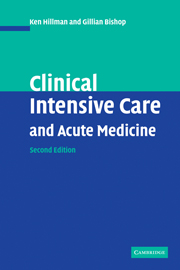Book contents
- Frontmatter
- Contents
- List of troubleshooting tips
- Preface to the first edition
- Preface to the second edition
- Acknowledgements
- 1 A systematic approach to caring for the seriously ill
- 2 Organisation of an intensive care unit
- 3 Routine care of the seriously ill
- 4 Fluid therapy and electrolytes
- 5 Nutrition and metabolism
- 6 Acid–base balance
- 7 Sedation, analgesia and muscle relaxants
- 8 Shock and anaphylaxis
- 9 Multiorgan failure
- 10 Cardiopulmonary resuscitation
- 11 Body temperature disorders
- 12 Transport of the seriously ill
- 13 Infection
- 14 Trauma
- 15 Poisoning
- 16 Acute respiratory failure
- 17 Interpretation of the portable chest film
- 18 Specific respiratory problems
- 19 Ventilatory techniques
- 20 Cardiorespiratory monitoring
- 21 Acute cardiovascular failure
- 22 Specific cardiovascular problems
- 23 Acute intracranial disasters
- 24 Specific intracranial problems
- 25 Critical care neurology
- 26 Acute renal failure
- 27 Critical care gastroenterology
- 28 Critical care haematology
- 29 Critical care endocrinology
- 30 Obstetric emergencies
- 31 Economics, outcome and ethics in intensive care
- Appendices
- Index
- References
27 - Critical care gastroenterology
Published online by Cambridge University Press: 07 September 2009
- Frontmatter
- Contents
- List of troubleshooting tips
- Preface to the first edition
- Preface to the second edition
- Acknowledgements
- 1 A systematic approach to caring for the seriously ill
- 2 Organisation of an intensive care unit
- 3 Routine care of the seriously ill
- 4 Fluid therapy and electrolytes
- 5 Nutrition and metabolism
- 6 Acid–base balance
- 7 Sedation, analgesia and muscle relaxants
- 8 Shock and anaphylaxis
- 9 Multiorgan failure
- 10 Cardiopulmonary resuscitation
- 11 Body temperature disorders
- 12 Transport of the seriously ill
- 13 Infection
- 14 Trauma
- 15 Poisoning
- 16 Acute respiratory failure
- 17 Interpretation of the portable chest film
- 18 Specific respiratory problems
- 19 Ventilatory techniques
- 20 Cardiorespiratory monitoring
- 21 Acute cardiovascular failure
- 22 Specific cardiovascular problems
- 23 Acute intracranial disasters
- 24 Specific intracranial problems
- 25 Critical care neurology
- 26 Acute renal failure
- 27 Critical care gastroenterology
- 28 Critical care haematology
- 29 Critical care endocrinology
- 30 Obstetric emergencies
- 31 Economics, outcome and ethics in intensive care
- Appendices
- Index
- References
Summary
Fulminant hepatic failure
Fulminant hepatic failure (FHF) is defined as encephalopathy due to massive hepatic necrosis within 8 weeks of the onset of the primary illness, with no evidence of previous liver disease. This excludes subacute hepatic necrosis, acute-on-chronic hepatic failure and chronic hepatic encephalopathy. It is a relatively rare disease.
Aetiology
Viral causes: the viruses that cause hepatitis A, B, C, D, E and non-A, non-B, as well as Epstein–Barr virus, herpes simplex virus and cytomegalovirus (CMV). Viral causes account for over 70% of all cases of fulminant hepatic failure.
Paracetamol poisoning.
Idiosyncratic drug reactions: antituberculous drugs, methyldopa, monoamine oxidase inhibitors, halothane hepatitis.
Direct drug toxicity: carbon tetrachloride, yellow phosphorus.
Ischaemia, hypoxia, heatstroke, shock.
Budd–Chiari syndrome, lymphoma.
Acute fatty liver of pregnancy.
Wilson's disease.
Clinical features
The diagnosis can be difficult especially in the early stages. Patients usually do not have signs of chronic liver failure such as spider naevi and palmar erythema.
Encephalopathy is the hallmark of this disease and disturbance in the level of consciousness may be the only presenting feature.
The clinical course may be over hours or days.
Encephalopathy: Many factors have been implicated but as yet no definite cause of the encephalopathy has been found. Ammonia, free fatty acids, phenols, bilirubin, bile acids, mercaptans, false neurotransmitters, benzodiazepine analogues and γ-aminobutyric acid (GABA) are some of the implicated compounds.
Stages of encephalopathy:
Grade I: mood change and confusion.
Grade II: drowsiness and increase in muscle tone.
Grade III: stuperose but rousable.
Grade IV: unrousable to maximum stimulation.
There are no specific clinical or EEG features that can be used to differentiate this encephalopathy from those associated with other metabolic disturbances.
- Type
- Chapter
- Information
- Clinical Intensive Care and Acute Medicine , pp. 543 - 574Publisher: Cambridge University PressPrint publication year: 2004



